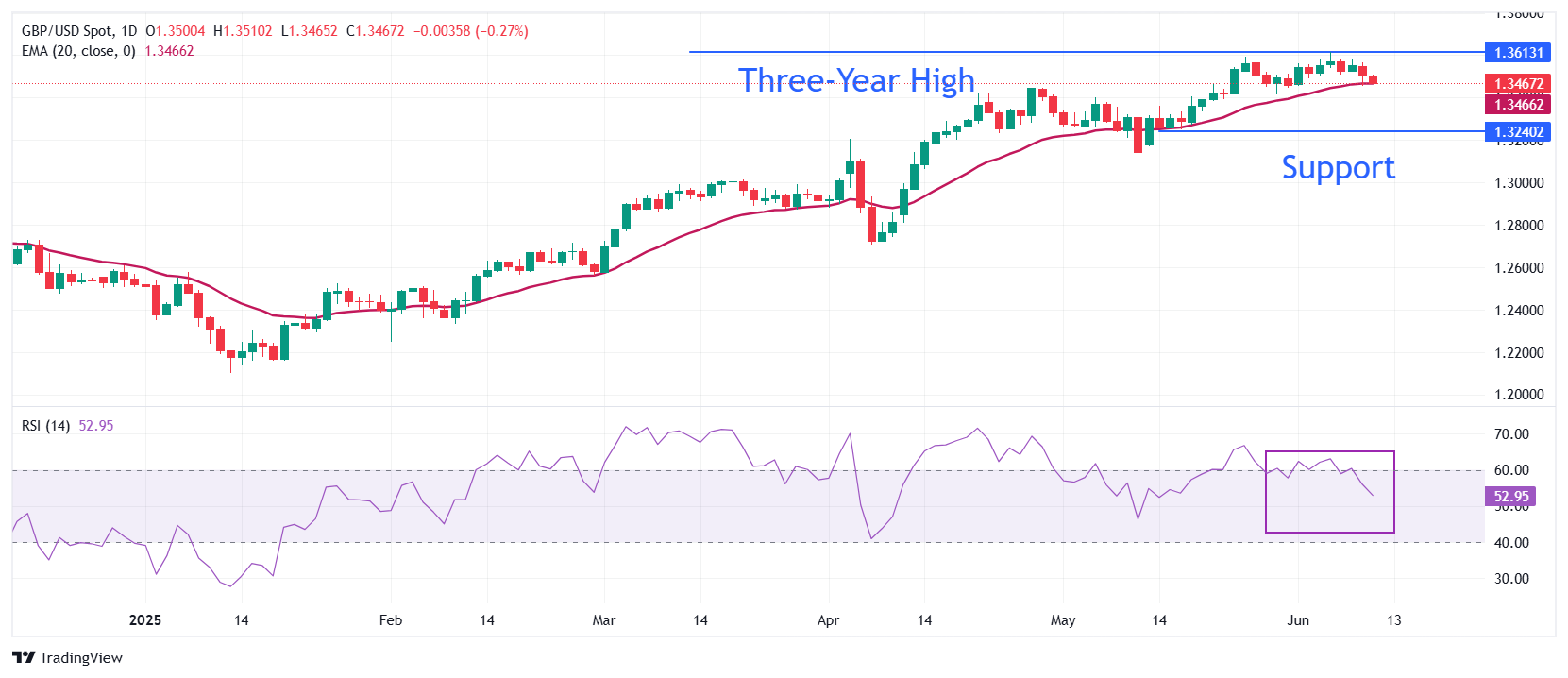
The Pound Sterling edges down below 1.3500 against the US Dollar ahead of the US CPI data for May.
Soft UK employment data paves the way for a BoE interest rate cut in August.
Trade tensions between the US and China appear to have eased after a two-day meeting in London.
The Pound Sterling (GBP) trades lower to near 1.3480 against the US Dollar (USD) during European trading hours on Wednesday. The GBP/USD pair ticks down as the US Dollar trades broadly stable ahead of the United States (US) Consumer Price Index (CPI) data for May, which will be published at 12:30 GMT.
The US Dollar Index (DXY), which tracks the Greenback’s value against six major currencies, edges up slightly to near 99.15.
Investors will pay close attention to the US inflation data as it will influence market expectations for the Federal Reserve’s (Fed) monetary policy outlook. As measured by the CPI, headline inflation is expected to have risen to 2.5% on year from 2.3% in April. In the same period, core CPI – which excludes volatile food and energy prices – is expected to have grown by 2.9%, faster than the prior 2.8%. On month, both headline and core CPI are expected to have grown by 0.2% and 0.3%, respectively.
Signs of accelerating price pressures would allow Federal Reserve (Fed) officials to commit to holding interest rates steady until they get clarity over the outcome of the tariff policy by US President Donald Trump after returning to the White House.
Even if inflation data came in lower than expected, Fed policymakers are unlikely to support early interest rate cuts, as they have been citing concerns over de-anchoring consumer inflation expectations under the leadership of Donald Trump.
On the global front, trade tensions between the US and China have de-escalated somewhat as the White House has signaled a positive outcome from the two-day meetings between trade representatives of both countries held in London. US Secretary of Commerce Howard Lutnick expressed confidence that both nations will roll back export restrictions.
Daily digest market movers: Pound Sterling extends underperformance against its peers
The Pound Sterling extends its downside move against its major peers on Wednesday, extending the previous day’s sell-off. The British currency faces sharp selling pressure on Tuesday after the United Kingdom (UK) Office for National Statistics (ONS) reported a weak set of labor market data for three months leading up to April.
The data showed cracks emerging in the UK labor market as the decision by Chancellor of the Exchequer Rachel Reeves to raise employers’ contribution to social security schemes to 15% from 13.8% went into effect in April.
According to the report, the Unemployment Rate accelerated to 4.6%, the highest level seen since July 2021. Also, labor demand slowed significantly, and wages grew at a moderate pace.
Soft UK employment data has increased market expectations that the Bank of England (BoE) will reduce interest rates by more than what investors had projected earlier. “Weak jobs and slower pay growth may tip the balance in favour of an August cut," HSBC analysts said.
Later this week, investors will focus on the UK monthly Gross Domestic Product and the factory data for April, which will be released on Thursday. The UK economy is expected to have shrunk by 0.1% after expanding 0.2% in March. On month, both the Manufacturing and Industrial Production data are expected to have contracted again.
Technical Analysis: Pound Sterling corrects to near 20-day EMA

The Pound Sterling declines to near the 20-Day Exponential Moving Average (EMA) at around 1.3467, indicating uncertainty in the near-term trend. The GBP/USD pair faced selling pressure on Tuesday after failing to revisit the three-year high of 1.3617.
The 14-day Relative Strength Index (RSI) falls sharply towards the 50 neutral level, indicating that the upside potential is capped.
On the upside, the three-year high of 1.3617 will be a key hurdle for the pair. Looking down, the May 15 low of 1.3258 will act as a key support zone.
* The content presented above, whether from a third party or not, is considered as general advice only. This article should not be construed as containing investment advice, investment recommendations, an offer of or solicitation for any transactions in financial instruments.


